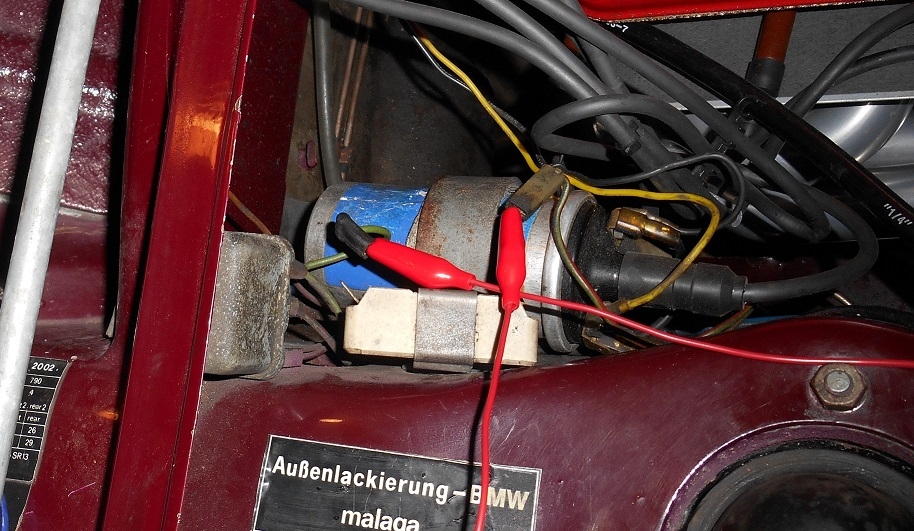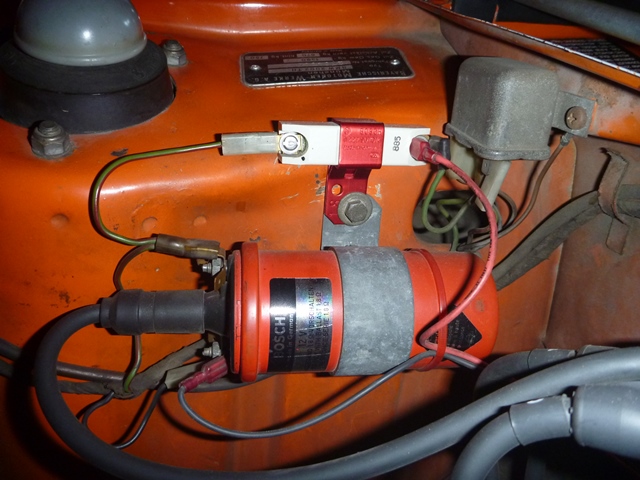Based on this thread, I have a Bosch Red Coil on order.Injected or not, a decent coil can get cooked without an appropriately matched ballast resistor.



You are using an out of date browser. It may not display this or other websites correctly.
You should upgrade or use an alternative browser.
You should upgrade or use an alternative browser.
Issues after “Julia” has been running for an hour or more with high ambient temperature
- Thread starter Midwestbike
- Start date
So I got a new coil and it worked great for about half of the drive home 4 hours. Then it did the exact same things. I pulled over let it cool and then it would last about an hour. After the third time I then put in the original coil and it made it all the way home with any issues. The car is injected and there is no vapor lock and the fuel hoses are new(ish). The fuel filter has less than 2k on it and the fuel level sender works great. I was getting about 20-22 mpg on the way down to Hot Springs and got 21-23 mpg on the way home.The failing coil scenario may be the most likely explanation. Merely swapping it out for virtually any generic similarly shaped 12v coil should resolve the doubts. But for the mention of peRtronix, points and condenser would have made the list of suspects. That said, peRtronix, may not be infallible when it comes to heat exposure. Further on the subject of electrics, compromised wiring (e.g., dubious insulation) could easily account for an otherwise unexplained engine shut down or non-start. In the abstract, heat may cause ignition wiring at or near the coil to contact a ground (e.g., bare sheet metal) since the same heat may cause just enough metal expansion to cause a short. (This scenario can occur if there is significant engine movement and wiring is brittle or otherwise compromised.) Lastly, assuming your fuel is delivered electronically via a Djet system, the peRtronix does not obviate the need to check the fuel injector points at the bottom of the distributor (and related wiring), fuel pump/relay wiring and wiring to pressure sending unit.
If your model is “injected,” as seemingly indicated, it is doubtful the vehicle is experiencing vapor lock, especially since most of the fuel system is pressurized. However, aft of the fuel pump (between tank and pump/tank reservoir) it is possible a poor hose connection or compromised hose might permit air to enter the system, in turn, causing momentary cavitation at the pump. One means of eliminating this remote possibility is a simple pressure gauge spliced between the fuel filter (usually under the battery tray) and the feed hose to the injector manifold. If the pressure remains steady, air in the system might only cause a hiccup and not a complete shut down.
Old braided high pressure fuel hose does not last forever. It can possibly sweat, allowing pressurized fuel to escape without significant warning other than the occasional fuel smell, and occasional rough running - or worse.
The filter age is probably a non issue too, especially if the gauge indicates normal fuel pressure is being maintained. If in doubt, remove it and try blowing through the filter. If that indicates serious resistance, you have an answer. As a simple field repair, you can still flush it in reverse to unclog it.
Related consideration may be failing fuel pump. https://e9coupe.com/forum/threads/1974-csi-stalling-issues.38253/
This thread might be of interest. https://e9coupe.com/forum/threads/1974-csi-stalling-issues.38253/
Something similar >>

View attachment 141604
I was reading about things that cause coils to run hot and one of them is the ignition timing and dwell. That will be my next endeavor.
So now after reading a bunch of the links from earlier posts, I will try a red coil and also to continue working on the wiper motor. It gave out the last 3 hours of the drive and kept having to pull over tap it and then pray it would last.... so much fun my better half said she would not be doing that again.
Last edited:
I have sort of tested that by pulling in to the gas stations and filling up and it still not running correctly until it had cooled off.What if the variable is not temperature but time?
it’s a free test to loosen the gas cap. If you air being sucked into your tank you would have your answer in seconds…
Try it with a blue coil (no resistor) and maybe points put back in?
Had no issues with blue coils in all the old bmws I had.
Carry a spare coil and drive a long time.
If it fails like before, was the coil overly hot?
Had no issues with blue coils in all the old bmws I had.
Carry a spare coil and drive a long time.
If it fails like before, was the coil overly hot?
Last edited:
We ran into a similar situation as the temp warmed in Georgia and the car would heat soak after shutdown. On the trip to Vintage with high temps we also had a few times when it was bogging down for a few seconds and then would clear up. I suspected it could be the coil failing due to heat We bought a used $20 blue coil with the wire to the distributor broken off in it that we repaired. From then on it ran ok and only bogged down once after the trip home (after a shut down heat soak). I have since installed a Bosch red coil but yet to try it out.
The difference is we have Webers with Pertronix and not injectors. It does seem to be temperature (80+) perhaps related to fuel. We will see as the summer continues.
The difference is we have Webers with Pertronix and not injectors. It does seem to be temperature (80+) perhaps related to fuel. We will see as the summer continues.
Be sure to use the 1.8 ohm ballast with the red coil, the original black coil has a 1.1 ohm ballast.We ran into a similar situation as the temp warmed in Georgia and the car would heat soak after shutdown. On the trip to Vintage with high temps we also had a few times when it was bogging down for a few seconds and then would clear up. I suspected it could be the coil failing due to heat We bought a used $20 blue coil with the wire to the distributor broken off in it that we repaired. From then on it ran ok and only bogged down once after the trip home (after a shut down heat soak). I have since installed a Bosch red coil but yet to try it out.
The difference is we have Webers with Pertronix and not injectors. It does seem to be temperature (80+) perhaps related to fuel. We will see as the summer continues.
ChrisBe sure to use the 1.8 ohm ballast with the red coil, the original black coil has a 1.1 ohm ballast.
I will verify it. However, is the ballast needed with Pertronix?
Thx, Dan
I think so
Chris:I think so
I am finding mixed messages online so have found a Bosch 1.8 Ohm Resistor and that is the way I will go to be safe. I appreciate your input as always.
Dan
From an article I just read:
The Pertronix documentation explicitly states that the total resistance of the coil plus the ballast resistor must be at least 3 ohms. If it’s less, the ignition will draw more current than the Pertronix is rated for, and fry it.
The Pertronix documentation explicitly states that the total resistance of the coil plus the ballast resistor must be at least 3 ohms. If it’s less, the ignition will draw more current than the Pertronix is rated for, and fry it.
This 2002faq article had comments from our own Rob Siegel that the diagram on the right is in the instructions, keep the ballast.
Agreed and thanks
With a Pertronix, you have to run the resistor with either the stock or red coil but must bypass the resistor with a "blue" coil. If you run without a resistor with a coil that requires one, you run the risk of frying the Pertronix because it may not be able to handle the higher current draw. You can also overheat the coil itself. If you use a resistor with a blue coil, you'll get much weaker sparks but your points will last longer.
From:

 www.bmw2002faq.com
www.bmw2002faq.com
With a Pertronix, you have to run the resistor with either the stock or red coil but must bypass the resistor with a "blue" coil. If you run without a resistor with a coil that requires one, you run the risk of frying the Pertronix because it may not be able to handle the higher current draw. You can also overheat the coil itself. If you use a resistor with a blue coil, you'll get much weaker sparks but your points will last longer.
From:

Ignition Coil Myths Busted
Written by Zenon Friday, 24 March 2006 There seems to be a lot of confusion around coils and resistors so here is my attempt to clarify. compiled from so i am upgrading to pertronix..... and other sources The original stock "black" Bosch coil, with an external resistor, is actually a great setup ...
 www.bmw2002faq.com
www.bmw2002faq.com
That is an awesome article that I haven’t read in a few years!
tochi
Well-Known Member
- Messages
- 189
- Reaction score
- 93
I am not readily conversant with Pertronix installation issues and, for that reason, my thoughts are likely to be misplaced. Some confusion may lie with the fact that there are three Pertronix versions: Ignitors I, II and III (see chart below). Rob S's article apparently does not distinguish between the various versions, but it seems he is working with Ignitor "I." Instructions for that version, as Chris notes, indicates required resistance. However, the randomly-chosen directions for the Ignitor II installation, suggests two possible approaches. It recommends disconnecting the ballast resistor for "optimum" performance, but alternatively allows for retention. (Again, this later information only applies to the Ignitor II.) I would think the best approach is to follow the instructions that came with the specific unit you are installing.Chris
I will verify it. However, is the ballast needed with Pertronix?
Thx, Dan
In the interest of originality and simplicity, the discussion understandably focused on Bosch coils. It should also be remembered that, just like spark plugs, there are many ignition coil choices, and not exclusively coils bearing the Bosch label.
Last edited:
If, by any sad chance, this continues after you have replaced the ignition system, Maybe you could T the fuel line and tape the gauge to a wiper...just to verify you're not losing fuel pressure and causing the event.
